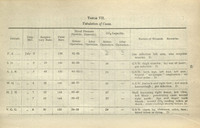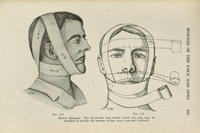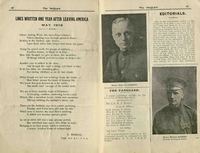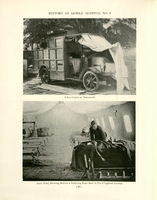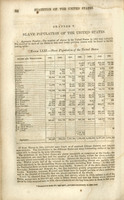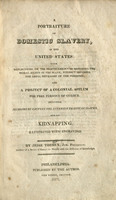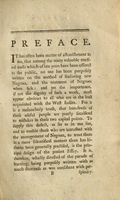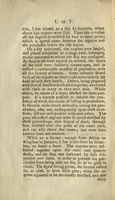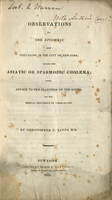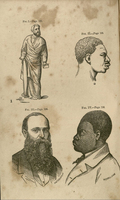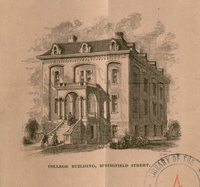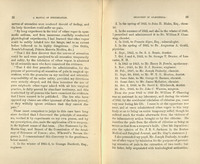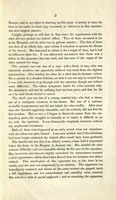Rare Books and Journals
Dublin Core
Title
Rare Books and Journals
Description
Rare books in the Center's collections.
Collection Items
A leaf from the Canon Medicinae of Avicenna
This manuscript copy of Avicenna's Canon, written by Mordechai bar Elia in a rabbinical hand, was formerly in the library of Prince Dietrichstein of Nikolsburg.
A Quarter of a Century with The Free Hospital For Women
A small volume of annotated photographs of the interiors and exteriors of the Free Hospital for Women located in Brookline Massachusetts, taken in the late 19th century
“Plunged in Front of an ‘L’ Train,” May 18, 1896.
As this newspaper article reports, nineteen year old Benjamin Stone of New York, afflicted with headaches, threw himself in front of a train and committed suicide. The article is part of a five-volume collection of newspaper accounts of several…
Experimental pistol-shooting at short range, 1881.
D.B.N. Fish, a physician and medical examiner at Amherst, compiled studies of gunshot residue; the item displayed shows a shot from a Smith and Wesson revolver at a distance of four inches. Fish was attempting to determine whether any differences…
Medical jurisprudence; or, A code of ethics and institutes, adapted to the professions of physic and surgery.
Thomas Percival’s Medical ethics, published in 1803, is considered the first fundamental treatise on the conduct of physicians in hospital and private practice. Medical ethics was an expanded version of this earlier pamphlet, Medical jurisprudence. …
Medical jurisprudence.
5th American from the 7th and improved London edition,
with additions by Edward Hartshorne. Page 674.
Taylor’s Medical jurisprudence was a standard manual for the study of legal medicine. It was first printed in London in 1844, and an American edition followed in the next year. At least twelve editions were produced by the end of the 19th century,…
"Jake Magrath," 1939.
This parody of Rudyard Kipling’s poem “Mandalay” was distributed to the members of the St. Botolph’s Club, where Magrath lived for many years—“Number Four” was the club’s address on Newbury Street at that time.
Sixteen introductory lectures to courses of lectures upon the institutes and practice of medicine, with a syllabus of the latter (Philadelphia : Bradford and Innskeep, 1811)
This printed version of Rush’s medical lectures at the University of Pennsylvania includes an 1810 lecture on the study of medical jurisprudence—thought to be the first American treatise published on the subject. Rush opens his lecture stating,…
Medical jurisprudence; a syllabus for students at Boston University, Harvard, Tufts and Yale Medical Schools, Formulated 1947. Revised 1957. [Boston. 1957]. Page 23.
First formulated in 1947 and, as here, reissued ten years later, is a summary of laws relating to medical practice for students, illustrating some of the wide-ranging areas in which legal medicine could be involved.
Plate 5. License plate imprint in wood utility pole.
The last external program of the Department of Legal Medicine was the Research on Fatal Highway Collisions project; Alfred L. Moseley, a psychologist, was the principal investigator. The project, funded by a five-year grant from the National…
Bookplate of the George Burgess Magrath Library of Legal Medicine
In the 1920s, New England heiress Frances Glessner Lee (d. 1962) became fascinated with the colorful crime-solving career of George Burgess Magrath (1870-1938), the medical examiner for Suffolk County and an instructor in legal medicine at Harvard…
"Postmortem examination in cases of suspected rape," Page 313.
Original research into medico-legal problems was one of the Department's fundamental activities from the outset, and over one hundred articles were published by members of the staff from 1940 to 1954. The article by O. J. Pollak uses a composite of…
"An account of the first use of sulphuric ether by inhalation as an anaesthetic in surgical operations" by C. W. Long. Pages [705]-713.
Describes Crawford W. Long's experiences with surgical operations using sulphuric ether in 1842.
Photograph from the Dedication Exercises of the Oscar C. Tugo Circle, Pasteur & Longwood Avenues, Boston, October 18, 1921.
Private Oscar C. Tugo enlisted on May 7, 1917; he was killed as a night orderly during the air raid on Base Hospital No. 5 on September 4, along with Lieutenant William Fitzsimons, Privates Rudolph Rubino, Jr., and Leslie G. Woods. On October 18,…
Photograph of Oscar C. Tugo.
Private Oscar C. Tugo enlisted on May 7, 1917; he was killed as a night orderly during the air raid on Base Hospital No. 5 on September 4, along with Lieutenant William Fitzsimons, Privates Rudolph Rubino, Jr., and Leslie G. Woods. On October 18,…
Circular, [New York, N.Y., October, 1914]
Established and sponsored by members of the American colony in Paris soon after the outbreak of hostilities, the American Ambulance Hospital was ready for the reception of patients on September 1, 1914, at the Lycee Pasteur in Neuilly, Paris. The…
The Vanguard : First in France
A monthly newsletter from the personnel of Base Hospital No. 5--the first publication from the American Expeditionary Forces--began to appear in November 1917. The issue displayed commemorates a year's anniversary since the departure for France and…
The Story of U.S. Army Base Hospital No. 5 by a Member of the Unit.
Harvey Cushing published this historical account of Base Hospital No. 5 soon after the war's end, as it was "one of the Units of the American Expeditionary Force to be sent overseas; it was the first to suffer casualties at the hands of the enemy;…
Concerning Base Hospital No. 5 : a Book Published for the Personnel of Base Hospital No. 5, France, 1917-18-19.
Concerning Base Hospital No. 5 was, according to its editors, originally conceived "on the same idea of a college year book, to contain personal write-ups of every member of the unit…. Steps were immediately taken to get together pen sketches of…
U.S. Army, American Expeditionary Forces
Defensive Measures against Gas Attacks
The A.E.F. issued these guidelines on instructions and preventive measures against gas attacks, including carrying masks and respirators, frequent drills, alarms, and inspection of equipment. The guidelines include instructions on anti-gas…
'Sharp gunfire : tremors; tremophobia. A patient's (an artist's) description of his feelings." Pages 310-311.
Harvard neuropsychiatrist, E. E. Southard, drew on the medical literature from the first three years of the war--English, French, Italian, Russian, German, and Austrian--to compile this study of nearly 600 cases related to shell-shock and other…
Reports of the Special Investigation Committee on Surgical Shock and Allied Conditions. No. 2. Investigation of the Nature and Treatment of Wound Shock and Allied Conditions.
Soon after his arrival in France with Base Hospital No. 5, Walter B. Cannon was joined to group of surgeons with the B.E.F. at Casualty Clearing Station No. 33 in Béthune, to study the effects of traumatic shock in association with war wounds. He…
Letter from Robert I. Lee to Ella Lowell from Base Hospital No. 5, January 24, 1918.
Professor of Hygiene at Harvard, Roger I. Lee was a member of the Surgical Unit in 1915. He was a Major in the Medical Reserve Corps at the United States' entry into the war. Assigned to Base Hospital No. 5, Lee was its officer in command through…
"The Oscar C. Tugo Circle, October 18, 1921."
Private Oscar C. Tugo enlisted on May 7, 1917; he was killed as a night orderly during the air raid on Base Hospital No. 5 on September 4, along with Lieutenant William Fitzsimons, Privates Rudolph Rubino, Jr., and Leslie G. Woods. On October 18,…
The Vanguard : First in France (May 1918)
A monthly newsletter from the personnel of Base Hospital No. 5--the first publication from the American Expeditionary Forces--began to appear in November 1917. The issue displayed commemorates a year's anniversary since the departure for France and…
"The Commanding Officer and the Queen, Camiers, July 6, 1917"
Harvey Cushing published this historical account of Base Hospital No. 5 soon after the war's end, as it was "one of the Units of the American Expeditionary Force to be sent overseas; it was the first to suffer casualties at the hands of the enemy;…
Mobile Hospital No. 6.
Concerning Base Hospital No. 5 was, according to its editors, originally conceived "on the same idea of a college year book, to contain personal write-ups of every member of the unit…. Steps were immediately taken to get together pen sketches of…
"Table XC. Classification of Slave Holders in the United States."
Statistical profile of American slave holders in 1850.
"Table LXXI. Slave population of the United States."
Statistical profile of number of slaves in America in 1850.
Title-page of A Portraiture of Domestic Slavery (1817)
Title-page of A Portraiture of Domestic Slavery (1817).
Preface to An Essay on the More Common West-India Diseases (1764)
Beginning of preface to An Essay on the More Common West-India Diseases.
Title page to An essay on the more common West-India diseases (1764)
Title page to An essay on the more common West-India diseases (1764)
An account of the slave trade on the coast of Africa by Alexander Falconbridge. London : Printed by J. Phillips, 1788. Page 034-035.
Description of a sale of slaves.
Title page of The speech of the right honourable William Pitt, on a motion for the abolition of the slave trade, in the House of Commons, on Monday the second of April, 1792.
Speech of William Pitt on the abolition of slavery in England.
The speech of the right honourable William Pitt, on a motion for the abolition of the slave trade, in the House of Commons, on Monday the second of April, 1792. Pages 002-005.
Speech of William Pitt on the abolition of the slave trade.
"Advice to the planters of the southern states", Pages 037-039.
Advice on the medical care of slaves in the southern states.
Title page of Observations on the epidemic now prevailing in the city of New-York by Christopher C. Yates.
Title-page of Observations on the epidemic now prevailing in the city of New-York by Christopher C. Yates.
Title-page of Negroes and Negro slavery : the first an inferior race: the latter its normal condition by J. H. Van Evrie.
Historical justification for slavery.
Frontispiece of Negroes and Negro slavery : the first an inferior race: the latter its normal condition by J. H. Van Evrie.
Historical justification of slavery.
Title-page of The Two-fold Slavery of the United States (1854)
Title-page of The two-fold slavery of the United States.
"Permanence of characteristics in different human species." Pages 529-532.
Louis Agassiz describes physical differences between Indians of Brazil and native Africans and warns against interbreeding of races.
"A slave at work with a head frame and mouth piece to prevent his eating, collar, spurs, &c with a 56 pound weight fastened to his body to prevent his absconding."
Engraving of a slave at work with a weight and mouth gag.
"The iron instruments used in the abominable traffic, the slave trade."
Engraving showing instruments used to hobble slaves.
Slave population of the United States
Statistical profile of the slave population of the United States in 1850.
Slaveholder population of the United States
Statistical profile of the slaveholding population of the United States in 1850.
The New England Female Medical College building on Springfield Street
Engraving of the New England Female Medical College building on Springfield Street, Boston.
Title-page of the Sixteenth annual catalogue and report of the New-England Female Medical College
Title-page of the sixteenth annual catalogue of the New England Female Medical College.
Sixteenth annual catalogue and report of the New-England Female Medical College.
A list of students in attendance at the New England Female Medical College during the 1863-64 term along with a list of the graduates of the Class of 1864.
Horace Wells' Demonstration of Anesthesia at Harvard Medical School
Describes Wells' unsuccessful attempt to demonstrate anesthesia using nitrous oxide at Harvard in December 1844.
Testimonies of Medical Students at Harvard to Horace Wells' Demonstration
Testimonial letters of William M. Cornell and Mason M. Miles in defense of Horace Wells.
Subscription list for the Morton Testimonial Association
Subscription list to raise funds for support of W. T. G. Morton and his family.
Charles T. Jackson Communicates the Ether Discovery
Jackson issued this publication “to interest both the Surgeon and the Solider, and with the intention of aiding the one and of informing the other” at the outbreak of the Civil War. The Manual provides illustrations and examples of cases from French…
First Case in Which Sulphuric Ether Was Exhibited by Inhalation in Labor
The passage displayed reproduces a letter from Nathan Cooley Keep (1800-1875), recounting the first use of ether anesthesia in labor; the patient was Henry Wadsworth Longfellow’s wife, Fanny, who gave birth to a daughter on April 7, 1847.
Unsuccessful cases of anesthesia by ether inhalation
Surgeon George Hayward performed the second operation employing ether at Massachusetts General Hospital on October 17, 1847, and then the first capital operation—the successful amputation of a leg—later that year. The following year, on April 12th,…
List of Patients Who Have Inhaled Ether or Chloroform for Surgical Operations in the Massachusetts General Hospital
List of patients who have inhaled ether or chloroform for surgical operations in the Massachusetts General Hospital up to April 1, 1848, furnished by H. J. Bigelow, M.D.
Insensibility during Surgical Operations Produced by Inhalation
Article from the Boston Medical and Surgical Journal describing first surgical operations using ether anesthesia.
Report of the Board of Trustees of the Massachusetts General Hospital, Presented to the Corporation, at their Annual Meeting, January 26, 1848.
Conclusions of a committee inquiring into the claims of W. T. G. Morton and Charles T. Jackson over the credit for the discovery of ether anesthesia.
James Robinson's Ether Inhaler
After the Abbott operation, Jacob Bigelow sent news of the discovery to Francis Boott (1792-1863), who was living in England. Boott communicated this to James Robinson, a surgeon-dentist, who then performed a painless tooth extraction on December…
Collection Tree
- Rare Books and Journals
- Boston Medical Library
- Christian Deetjen Collection on Witchcraft
- Edwin Newton Ohl Collection
- Friedrich Tiedemann Library of Anatomy and Physiology
- Kennedy Library of English Medical Books, 1700-1825
- Leona Baumgartner Collection of Fracastoro’s Syphilis
- Margaret and J. J. Longacre Memorial Library of Plastic Surgery
- Sir William Osler Collection
- Solomon M. Hyams Collection of Hebraic Medical Literature
- Harvard Medical Library
- Boston Medical Library






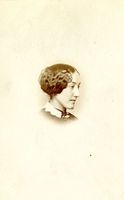



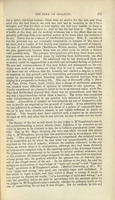


![Medical jurisprudence; a syllabus for students at Boston University, Harvard, Tufts and Yale Medical Schools, Formulated 1947. Revised 1957. [Boston. 1957]. Page 23. Medical jurisprudence; a syllabus for students at Boston University, Harvard, Tufts and Yale Medical Schools, Formulated 1947. Revised 1957. [Boston. 1957]. Page 23.](https://collections.countway.harvard.edu/onview/files/thumbnails/88c09c36089a1640c26501caf7fcbe34.jpg)



!["An account of the first use of sulphuric ether by inhalation as an anaesthetic in surgical operations" by C. W. Long. Pages [705]-713. "An account of the first use of sulphuric ether by inhalation as an anaesthetic in surgical operations" by C. W. Long. Pages [705]-713.](https://collections.countway.harvard.edu/onview/files/thumbnails/b3a6438aa81e229a586a05d7dce63f52.jpg)


![Circular, [New York, N.Y., October, 1914] Circular, [New York, N.Y., October, 1914]](https://collections.countway.harvard.edu/onview/files/thumbnails/30a1ce692a591ff32702990d0e6ce930.jpg)





